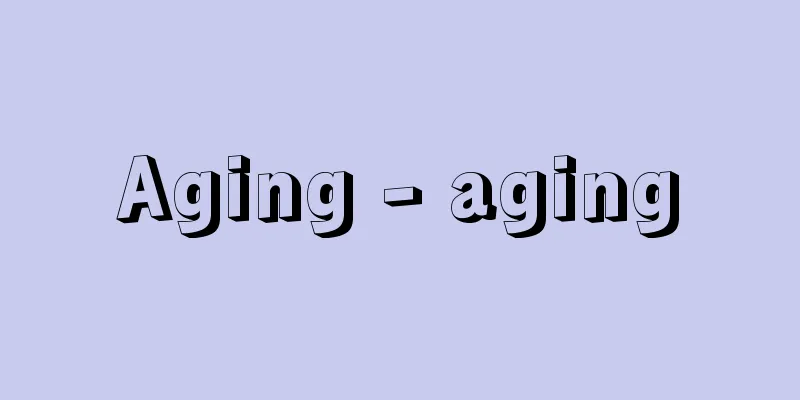Senility - rousui

|
Aging refers to a state in which the body ages and all organs and tissues are weakened by senile degenerative changes. Although the aging of each organ and tissue does not necessarily occur in parallel, senility is observed throughout the body. In senility, many organs, especially the brain, heart, and liver, show senile atrophy in the cells that are active in metabolism, and waste pigments are deposited in the cells, causing the function of each cell to decline. In addition, immune and adaptive functions decline, leading to an increase in the incidence of disease and a higher probability of death. Factors that cause senility include decreased secretion of hormones (especially sex hormones), senile sclerosis of blood vessel walls, changes in connective tissue throughout the body, atrophy and demyelination of brain cells (the phenomenon in which myelin sheaths degenerate and fall off due to various causes), decreased brain function due to changes in synaptic connections, and decreased immune surveillance function, all of which are said to be related to aging, but the causal relationship between these senile changes and senility has not yet been determined. Aging is a biological phenomenon that follows growth and maturation, and does not necessarily mean old age. As mentioned above, senility is a weakening caused by functional destruction at various levels, so if this functional destruction could be prevented, it is thought that aging without weakening would be possible. This is one of the goals of geriatrics (geriatrics), which has become popular in recent years. During senility or the aging process that leads to senility, morphological, biochemical, and physiological changes occur in many organs and tissues of the body. Research into these changes and the factors that cause them is being conducted at the molecular level, cellular level, tissue/organ level, and individual level. [Masazumi Kawakami] [Reference] | |Source: Shogakukan Encyclopedia Nipponica About Encyclopedia Nipponica Information | Legend |
|
生体が老化し、全器官・組織に老人性退行性変化が進んで衰弱した状態をいう。各器官・組織の老化は、かならずしも並行しておこるとは限らないが、老衰では生体全体に老化および衰弱が認められる。老衰においては、多くの器官、とくに脳・心臓・肝臓などの物質代謝の盛んな細胞に老化性萎縮(いしゅく)が現れ、細胞内には消耗性色素が沈着し、それぞれの細胞の機能は減退する。また、免疫機能や適応機能が低下する結果、疾病罹患(りかん)率が上昇し、死の確率が高くなる。老衰をもたらす要因については、ホルモン(とくに性ホルモン)の分泌減少、血管壁の老人性硬化、全身の結合組織の変化、脳細胞の萎縮・脱髄(だつずい)(髄鞘(ずいしょう)が種々の原因により変性脱落する現象)、シナプス結合の変化などによる脳の機能低下、免疫監視機能の低下など、老化との関連が指摘されているが、これらの老人性変化と老衰との因果関係はまだ確定されていない。 老化は成育、成熟に続く生物現象の一つであり、かならずしも老衰を意味しない。老衰は前述のように種々のレベルの機能破壊による衰弱であるため、もしその機能破壊を防ぐことができるならば、衰弱を伴わない老化が可能であると考えられている。近年盛んになってきた老年医学(老年病学)の一つの目標がこれである。老衰もしくはそれに至る老化の過程においては、生体の多くの器官・組織に形態学的、生化学的、生理学的な変化がおこる。これらの変化とそれを引き起こす要因は、分子レベル、細胞レベル、組織・臓器レベル、個体レベルなどに分けて研究が進められている。 [川上正澄] [参照項目] | |出典 小学館 日本大百科全書(ニッポニカ)日本大百科全書(ニッポニカ)について 情報 | 凡例 |
<<: The Rime of the Ancient Mariner
>>: Home for the aged - Roujinhome (English)
Recommend
Kamishimogi - formal attire
...The celebration of a 5-year-old boy's wear...
Lorikeet (Lorikeet) - Lorikeet (English spelling)
A general term for birds of the Trichoglossus genu...
Wackenroder, WH (English spelling) WackenroderWH
…Born in Berlin, he began writing at a young age,...
Vairocana Buddha (Vairocana) - Birushanabutsu
The Buddha with the strongest pantheistic color in...
Chemiluminescence
Also called chemiluminescence. A luminescence phen...
basic metabolism
...The advantage of this is that glycolysis, or t...
Ophthalmoscope
…Until fundus examination became possible, diseas...
Yoshida Shinto
A school of Shinto preached by the Yoshida family...
Russula virescens (English spelling) Russulavirescens
…[Rokuya Imaseki]. . … *Some of the terminology t...
Mount Rishiri
An active volcano on Rishiri Island, Hokkaido. It ...
Heraclianus
?‐413 A military man in the final days of the Roma...
Copaifera demeusii (English spelling)
…A type of natural resin. It was originally produ...
Vaccina virus
...It is well known that Jenner developed the vac...
al-Jabel al-Akhdal
…[Editorial Department]. … *Some of the terminolo...
Negative afterimage
...This refers to the visual effect that occurs w...









